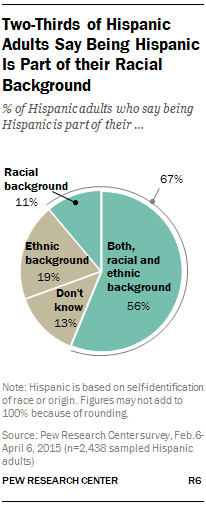
For Hispanics living in the United States, Hispanic identity is multidimensional and multifaceted. For some, it is defined most by their family’s country of origin, such as Mexican, Cuban or Dominican.48 For others, it is defined by pan-ethnic terms like Hispanic or Latino, emphasizing the commonalities of a diverse community.
At 54 million, Hispanics make up 17% of the nation’s population, and they are projected to grow to be 29% of the U.S. population in 2060, according to the Census Bureau.49 Between 1990 and 2013, the nation’s Hispanic population grew faster than any other racial or ethnic group.
Measuring racial identity among Hispanics has proved challenging for the Census Bureau. Currently, the Hispanic category is described on census survey forms as an ethnic origin and not a race. It is asked about separately from the race question, a practice also followed by many other surveys.
But when it comes to their racial identity, Latinos stand out from other Americans in their responses to race questions. For example, when asked about their race on Census Bureau decennial census and survey forms, many Latinos do not choose one of the standard racial classifications offered. Instead, more than any other group, Latinos say their race is “some other race,” mostly writing in responses such as “Mexican,” “Hispanic” or “Latin American.” Some 37% of Latinos did this in the 2010 census, as did 42% in the 2000 census.50 This is also the case on Pew Research Center surveys of Latinos. In the 2014 National Survey of Latinos, 25% of Latinos volunteered that their race is “Hispanic” or “Latino” and not one of the standard racial classification groups.
Hispanics’ responses to the 2010 and 2000 census raise an important question: Do Hispanics consider their Hispanic background to be part of their racial background, their ethnic background or both? According to the Pew Research survey, 11% of Hispanic adults say that their Hispanic background is part of their racial background, 19% consider it part of their ethnic background and 56% consider it part of both their racial and ethnic backgrounds. Taken together, two-thirds (67%) of Hispanic adults describe their Hispanic background as a part of their racial background.51
This finding has implications for how multiracial Latinos are identified. For example, Latinos who identify themselves as one race (such as white or black) when asked to fit themselves into the country’s current standard racial categorization, but then say they consider being Latino as part of their racial background as well, have effectively indicated a multiracial background. That makes this group of Latinos potentially part of the mixed-race population. Taking this broader view of the multiracial population, including Latinos who give one census race and also consider their Latino background part of their race would raise the U.S. multiracial population share to 8.9% from 6.9%.
This chapter incorporates this broader approach to Hispanic racial identity, exploring two possible ways to define and view definitions of mixed-race background among Hispanics: (1) those who say they are two census races (i.e., white and black) and are also Hispanic, a group consistently treated as multiracial throughout the report; and (2) those who name only one race (other than Hispanic), but also say they consider their Hispanic background to be part of their racial background. The chapter also explores other Hispanic racial identities, such as an Afro-Latino background and a background that includes roots among the indigenous peoples of the Americas, such as Native American, Maya, Taino or Quechua. These latter findings come from the Pew Research Center’s 2014 National Survey of Latinos.
I’ve never identified as a single race. I think partly that would be insulting to my parents because it would be leaving one or the other out.White and Hispanic woman, age 23
Who Considers Being Hispanic a Race?
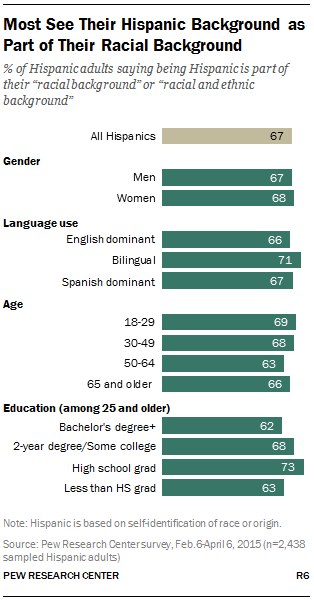
Across age groups, educational levels and language preference, most U.S. Hispanics consider their Hispanic background a part of their racial makeup. For example, 69% of Latinos ages 18 to 29 say their Hispanic background is part of their racial background, as do 68% of those ages 30 to 49, 63% of those ages 50 to 64 and 66% of those ages 65 or older.
Similarly, Hispanics who are Spanish-dominant (67%) are about as likely as bilingual (71%) and English-dominant (66%) Hispanics to consider their Hispanic background part of their racial background.52 Shares are similar by gender, and across educational attainment levels: Most Hispanics in each group consider their Hispanic background as part of their racial background.
Identifying Multiracial Hispanics

As noted, multiracial identity among Hispanics can be defined in two ways. The first definition matches that used throughout this report—multiracial adults are those who say the racial background of themselves, their parents or their grandparents includes two or more census races, regardless of whether they see their Hispanic background as a race. By this definition, 4.6% of adults who are Hispanic (or have a Hispanic parent or grandparent) have a multiracial background.53
The second multiracial definition includes those who say their Hispanic background is a part of their racial background and who indicate that their background also includes one other census race (such as white or black or Asian). Some 12.1% of Hispanic adults are multiracial by this addition. Adding in those who qualify as multiracial under the first definition, some 16.7% of all Hispanic adults in total would then be identified as having a multiracial background. Among the Hispanic multiracial group that is one census race and considers their Hispanic background to be their race, a large majority (79%) say their racial background is white and Hispanic.
The Multiracial Experience and Latinos
Multiracial identity is not only a reflection of the racial background on one’s family tree, but also a reflection of the social and cultural factors shaping how you were raised, how you see yourself and how the world sees you. For many mixed-race Hispanics, these factors may be as important as racial background in shaping their racial identity.
Do Hispanics with Multiple-Race Backgrounds Consider Themselves to Be Mixed Race?
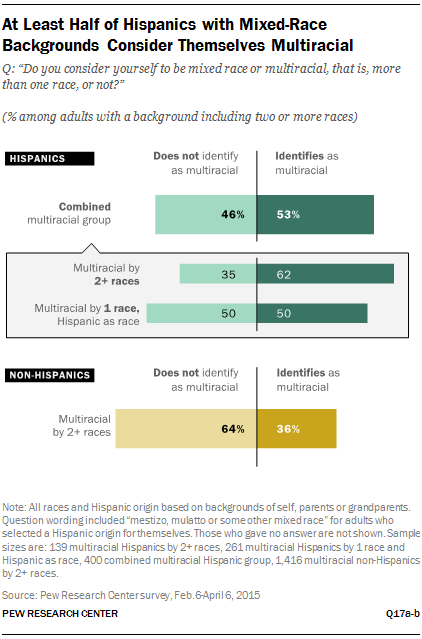
Even though many Hispanics report having a multiracial background, many may not consider themselves to be mixed race. For example, among Hispanic adults who have a multiracial background based on reporting two or more census races, 35% say they do not consider themselves mixed race. And among Hispanic adults who consider their Hispanic background part of their racial background and who also indicate one census race in their background, 50% say they do not consider themselves mixed race. By comparison, a greater share of non-Hispanic multiracial adults, 64%, says they do not consider themselves mixed race.
How Multiracial Hispanics Think Others See Them

How do mixed-race Hispanic adults believe strangers passing them on the street see their racial background? As noted earlier, this is one of the many ways the views of one’s racial identity might be shaped. For Hispanic multiracial adults, the answer depends on how their multiracial background is defined. However, no matter how it is defined, few mixed-race Hispanics say they are viewed as multiracial.
For example, among multiracial Hispanics who indicate their background includes two or more census races, 30% say most people would think they are white if they passed them on the street. An additional 24% say most people would see them as Hispanic, 17% as mixed race, 10% as black only and 4% as American Indian only.
However, for multiracial Hispanics who choose one census race but say they consider their Hispanic background to also be part of their racial background, the survey’s findings are very different. About half of these multiracial Hispanics (48%) say most people would think they are Hispanic if they passed them on the street. An additional 38% say they would be seen as white by most people, and just 8% say they would be seen as mixed race. About half of this group (48%) chooses white when asked about their own race, so it’s not surprising that about four-in-ten believe others see them as white.
By comparison, 55% of non-Hispanic multiracial adults say most people would think they are white if they passed them on the street, 26% say they would be seen as black by most people, 8% as mixed race and just 3% as Hispanic. But these findings vary among non-Hispanic multiracial adults. For example, among non-Hispanic biracial adults who are white and black, 61% say most people would think they are single-race black if they passed them on the street. By contrast, among non-Hispanic biracial adults who are white and American Indian, 88% say most people would think they are white.
Is a Multiracial Background an Advantage or a Disadvantage?
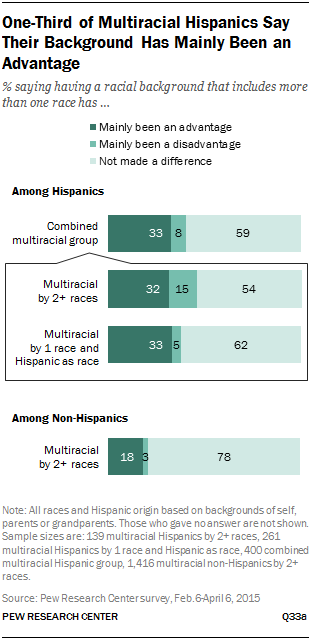
Like other multiracial adults, Hispanic multiracial adults are far more likely to say that having a racial background that includes more than one race has been an advantage in their lives than to say it has been a disadvantage. However, about half or more say it has not made a difference.
About a third (32%) of Hispanic adults who are multiracial because their background has two or more census races say their racial background has mainly been an advantage. A similar share (33%) says the same among Hispanics who consider their Hispanic background part of their racial background and also name one other census race in their background. This is nearly twice as large as the share (18%) of non-Hispanic multiracial adults who say the same.
By contrast, about one-in-six (15%) Hispanic adults who are multiracial by two or more census races say their multiracial background has mainly been a disadvantage. Among Hispanic adults who consider their Hispanic background part of their racial background and also name one other census race in their background, 5% say it has been a disadvantage in their life. By contrast, among multiracial non-Hispanic adults, just 3% say their multiracial background has mainly been a disadvantage.
Most Hispanic Multiracial Adults Have Felt Pride in Their Background
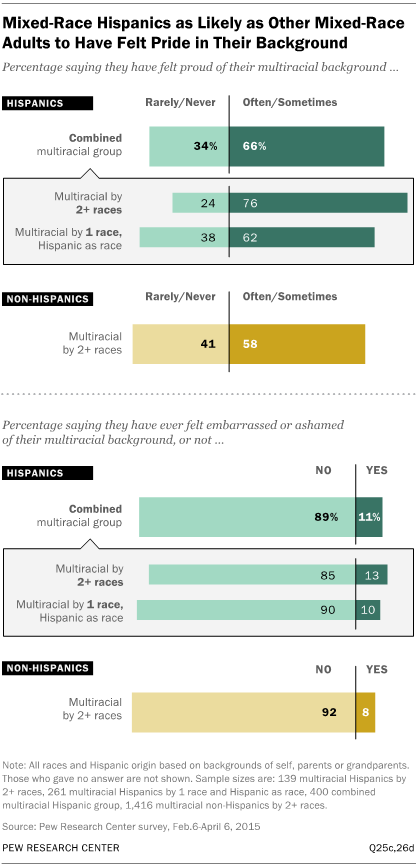
Compared with other mixed-race adults, Hispanic multiracial adults who are two or more races are more likely to say they have “often” or “sometimes” felt pride in their mixed-race background—76% say this. This is a higher share than that among Hispanic adults who consider their Hispanic background a race and also report one other race (62%). Among non-Hispanic multiracial adults, 58% say they have felt proud of their mixed-race background.
And across the two different groups of multiracial Hispanic adults, few say they have ever felt ashamed of their mixed-race background. Just 13% of Hispanics whose backgrounds includes two or more census races say this, as do 10% of Hispanics who consider their Hispanic background a race and also indicate one census race, and 8% of non-Hispanic multiracial adults.
Asking Hispanics About Racial Identities Beyond Census Classifications
In the sections above, we looked at what it would mean to consider a Hispanic background a racial one. This reflects what many Hispanics themselves write in on the decennial census form and other surveys when they enter “Hispanic” or “Latino” or a Hispanic origin (such as Mexican) when asked to provide their race. It also leads to about one-in-six Hispanics being identified as mixed race, even though many would not adopt that term to describe themselves.
But other recent Pew Research Center work suggests that even this broader approach to race doesn’t capture the full depth and wide spectrum of views that Hispanics have of their own racial identity. This is in part because grouping together diverse communities and nationalities into a single group masks many of the differences among them.54
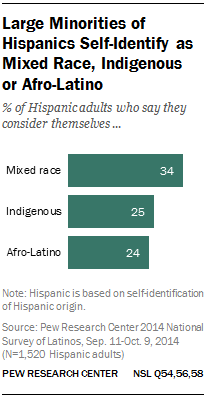
In the 2014 National Survey of Latinos (NSL), we approached Latinos’ views of race with an eye toward the specific ways that national and regional origin affects this view. Specifically, in that fall 2014 survey of 1,520 Latino adults,55 we asked about racial background in three ways by asking respondents if they consider themselves Afro-Latino or Afro-Caribbean or, for example, Afro-Mexican. Similarly, we asked Latinos if their background includes roots among the indigenous peoples of the Americas, such as Native American, Mayan, Quechua or Taino. Finally, we also explored mixed-race identity among Latinos using mixed-race terms such as mestizo or mulatto, terms that are used in countries like Mexico to capture a mixed indigenous and European heritage. We asked respondents these questions about their own background and that of their parents and grandparents.56
How the 2014 National Survey of Latinos asked about other racial identities
- Do you consider yourself to be mixed race, that is, belonging to more than one racial group, such as mestizo, mulatto or some other mixed race, or not?
- Do you consider yourself to be Afro-Latino, Afro-Caribbean, or Afro-‘COUNTRY OF ORIGIN,’ or not? [INTEVIEWER READ AS NEEDED: “An Afro-Latino or Afro-Hispanic is Latino or Hispanic with black African ancestry”]
- Do you consider yourself to be indigenous or Native American, such as (Maya, Nahua, Taino, Quiche, Aymara, Quechua*) or some other indigenous or Native American origin, or not?
*Examples provided varied according to the respondent’s country or region of origin
Note: For more detail on these questions and the exact phrasing, see 2014 National Survey of Latinos topline in Appendix D.
When asked directly about their mixed-race background, about one-in-three (34%) Latino adults say they consider themselves to be mixed race—defined as belonging to more than one racial group, such as mestizo, mulatto or some other mixed race. This is more than five times the share of Latinos (6%) who indicate two or more races or volunteer that they are “mixed race” when they are just asked to describe their race and told that they can select as many races as apply.57 Looked at another way, among the 34% of Latinos who self-identify as mixed race, mestizo or mulatto, only 13% also indicate a racial background with two or more races or volunteer that they were “mixed race” on the standard race question. About half (46%) of this group indicates their race or one of their races is white, and 24% volunteer that their race or one of their races is Hispanic or Latino. Fully 42% choose white as their only race, and 20% choose Hispanic as their only race.
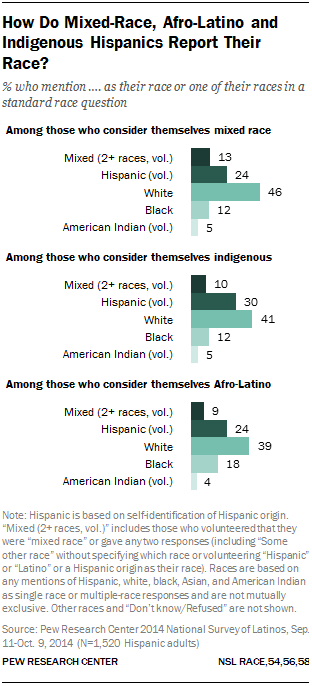
The NSL also finds that one-in-four (25%) Latino adults say they consider themselves indigenous or Native American, such as Maya, Nahua, Taino, Quiche, Aymara or Quechua, among others.58 But here, too, this share is higher than the 2% of Latinos who volunteer their race (or one of their races) as indigenous or Native American in the NSL’s standard race question. And looked at a different way, among Latinos who say they consider themselves indigenous or Native American when asked directly, just 5% volunteer their race or one of their races as Native American on the standard race question, while 41% indicate white as their race or one of their races and 30% volunteer their race as Hispanic or Latino alone or in combination. Again, a relatively high share of this group (36%) chooses white alone in describing their race, and about a quarter (27%) chooses Hispanic alone.
Finally, the survey found that about one-in-four (24%) Latino adults say they consider themselves to be Afro-Latino, Afro-Caribbean or another Afro-Latino origin, such as Afro-Colombian or Afro-Mexican. By comparison, just 8% of Latino adults indicated that their race or one of their races was black on the standard NSL race question. And here too, Latinos who say they are Afro-Latino do not necessarily also indicate they are black on the standard race question. For example, among this group, 18% say their race or one of their races is black on the standard NSL race question, but 39% say their race is white alone or in combination and 24% volunteer Hispanic or Latino as their race or one of their races.
When considering these racial identities through grandparents, the share of Latino adults with these backgrounds increases. Four-in-ten Latino adults (40%) consider themselves mixed race or have a parent or grandparent who is mixed race, up from 34% when considering only the background of the respondent. One-third (33%) consider themselves indigenous or have an indigenous parent or grandparent, up from 25% when considering only the respondent’s background. And 29% consider themselves Afro-Latino or have an Afro-Latino parent or grandparent, up from 24% when based on the respondent only.
These results shed light onto the multidimensionality of racial identity among Latinos and the challenges in capturing Hispanic racial identity through a standard race question.
The 2014 National Survey of Latinos (NSL) identified mixed-race Hispanics in two ways. On the one hand, the NSL directly asked Hispanic adults whether they considered themselves to be mixed race, as mentioned in the chapter and in the box in this chapter. On the other hand, the NSL included the Pew Research Center’s standard race question for telephone interviews, which allowed for multiple responses to race and also allowed respondents to volunteer their race as Hispanic/Latino or mixed-race. It also captured any other race responses given by the interviewee.
Based on the standard Pew Research race question, Hispanics identified as mixed-race includes Latinos who volunteered that they were “mixed race,” “mestizo,” “mulatto” or some other mixed race or gave any two responses (including “Some other race” without specifying which race that was or volunteering “Hispanic or Latino” or a Hispanic origin as their race) to the standard NSL race question.
Which of the following describes your race? You can select as many as apply… White, Black or African American, Asian or Asian American or some other race.
| 1 | White (e.g., Caucasian, European, Irish, Italian, Arab, Middle Eastern) |
| 2 | Black or African-American (e.g., Negro, Kenyan, Nigerian, Haitian) |
| 3 | Asian or Asian-American (e.g., Asian Indian, Chinese, Filipino, Vietnamese or other Asian origin groups) |
| 4 | Some other race (SPECIFY __________ IF NEEDED: What race or races is that?) |
| 5 | (DO NOT READ) Mixed race |
| 6 | (DO NOT READ) Hispanic/Latino (SPECIFY __________) |
| 7 | (DO NOT READ) Native American/American Indian/Alaska Native |
| 8 | (DO NOT READ) Pacific Islander/Native Hawaiian |
| D | (DO NOT READ) Don’t know |
| R | (DO NOT READ) Refused (e.g., non-race answers like American, Human, purple) |
Interviewers accepted up to four responses. They coded them in the respective categories following Pew Research instructions and recorded verbatim responses for “Some other race” and “Hispanic or Latino” mentions. The survey provider (SSRS) and Pew Research Center reviewed and verified these classifications and corrected some responses to the race question as needed.
Using this procedure, mixed-race Hispanics identified in the NSL race question may include people who said they were “white and Mexican” or “black and Latino and Dominican” or “Irish and Mexican.” Hispanic origin combinations such as “Puerto Rican and Cuban” are not counted as mixed race. In a few cases, when a verbatim response captured by interviewers was not clear, Pew Research used other survey questions, such as whether people considered themselves to be mixed race (Q54) and whether the respondent had a mixed Hispanic and non-Hispanic background through their parents and grandparents (Q52a, Q52b and Q53) to classify them as mixed-race or not.
For more on the survey’s methodology, see https://www.pewresearch.org/hispanic/2014/10/29/appendix-b-national-survey-of-latinos-methodology/